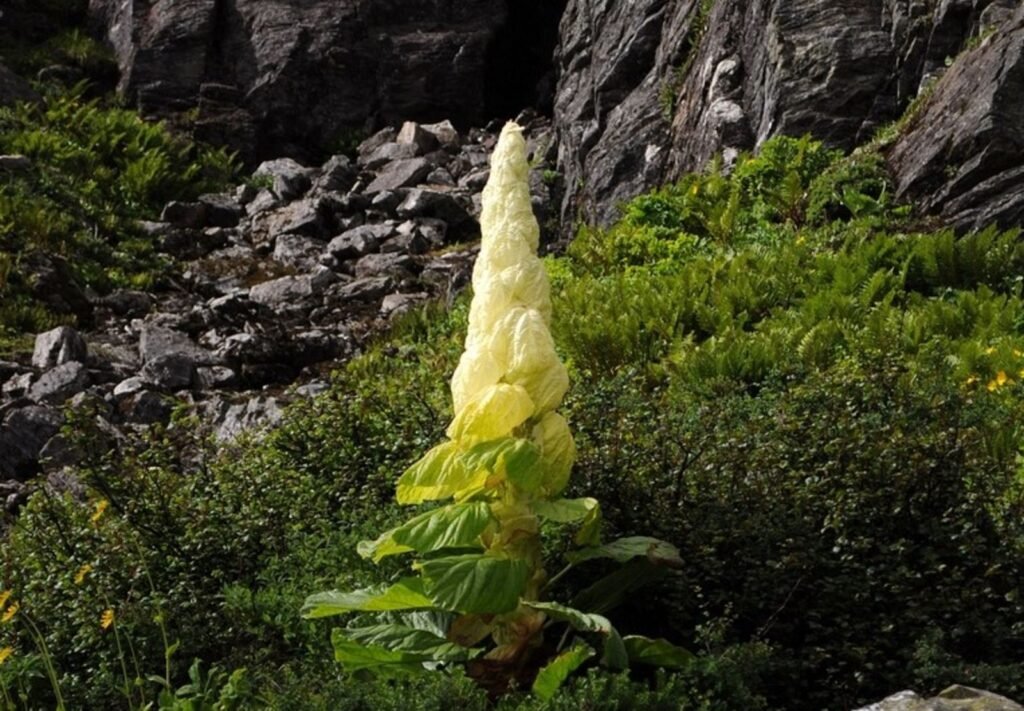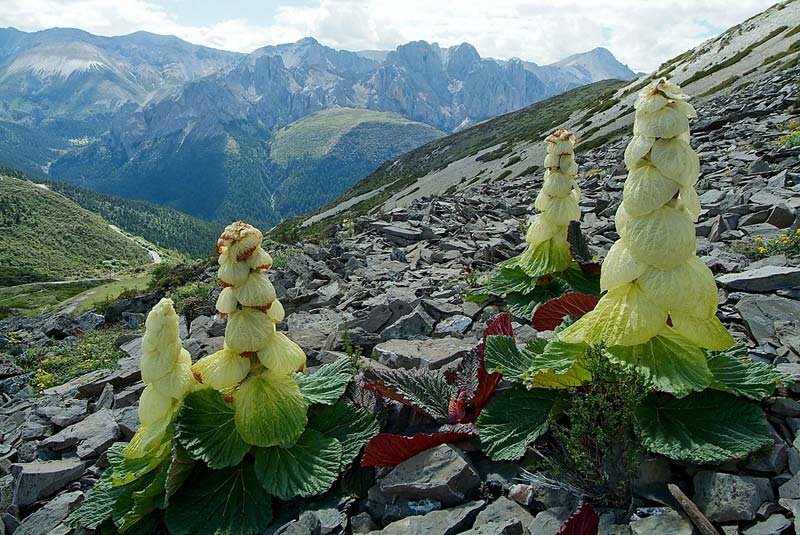The Noble Rhubarb: A Giant Herb with an Alpine Secret
The noble rhubarb (Rheum nobile) is not your ordinary plant. With its towering stature and striking, translucent bracts, it stands out as one of nature’s most fascinating botanical wonders. Native to the high-altitude regions of the Himalayas, from northeastern Afghanistan to Myanmar, this giant herb thrives at incredible altitudes of 4,000 to 4,800 meters. But it’s not just the altitude that makes the noble rhubarb remarkable—it’s its extraordinary adaptation that allows it to flourish in one of the harshest environments on Earth.
A Unique Adaptation for Survival
The noble rhubarb is often considered a “super plant” because of its specialized adaptation to the extreme conditions of the alpine zone. One of the most striking features of this plant is its translucent canopy of bracts that covers the flower stalk. This remarkable structure serves as a natural greenhouse, trapping sunlight and creating a warm microclimate that helps the plant’s flowers thrive despite the cold and often inhospitable conditions. This adaptation is crucial because the environment at such high altitudes can be harsh, with freezing temperatures and intense ultraviolet radiation. The noble rhubarb’s bracts act as a shield, protecting its reproductive organs while allowing the plant to capture as much sunlight as possible.

The Majesty of the Noble Rhubarb
The noble rhubarb’s towering stature makes it a standout in the high-altitude flora of the Himalayas. With its large leaves and tall flower stalks, it can reach impressive heights, often growing up to 2-3 meters tall. The plant produces striking, greenish-yellow flowers that are protected by its translucent bracts, making it look almost otherworldly. These bracts, which are large, papery, and translucent, create an ethereal glow around the flowers, making the plant look as if it’s part of a dreamscape.
Beyond its physical beauty, the noble rhubarb plays an important role in its ecosystem. It provides food and shelter for various species of insects, and its unique appearance makes it a key feature of the alpine meadows. While it’s difficult to cultivate in most places, the noble rhubarb is a symbol of resilience and the wonders of nature’s ability to adapt to the most extreme conditions.
A Rare Beauty in the Himalayan Landscape
The noble rhubarb is found in the rugged terrains of the Himalayan mountain range, a region known for its vast biodiversity and awe-inspiring landscapes. From northeastern Afghanistan to Myanmar, it grows in alpine meadows and grassy slopes at elevations where few other plants can survive. Here, it benefits from the cold but sunny environment, which helps it produce the energy it needs to survive and reproduce.
Given the harsh conditions in which it grows, the noble rhubarb is a rare sight. Its ability to adapt to such an extreme environment makes it an extraordinary example of nature’s ingenuity. Due to its limited distribution, it is not commonly seen outside of its native range, which only adds to its allure for botanists and nature lovers alike.

Why the Noble Rhubarb Matters
The noble rhubarb’s unique adaptation to extreme conditions is not just a botanical marvel but also an important symbol of biodiversity and the delicate balance of ecosystems in high-altitude regions. As the effects of climate change become more pronounced, plants like Rheum nobile are increasingly vulnerable. Protecting these rare species is essential for maintaining the ecological health of alpine regions.
Furthermore, the noble rhubarb’s distinctive features make it an invaluable subject for scientific study. Understanding how it survives in such an unforgiving environment could provide insights into plant resilience, which may help in preserving other species facing similar challenges in the future.
Conclusion: A Remarkable Alpine Wonder
The noble rhubarb is more than just a giant herb—it’s a testament to the adaptability and resilience of life in the most extreme corners of the Earth. With its translucent bracts, towering height, and unique position in the Himalayan ecosystem, Rheum nobile continues to awe and inspire those fortunate enough to encounter it. As this rare beauty thrives in the alpine zone, it serves as a reminder of the wonders that await discovery in the world’s most remote and rugged landscapes.
If you’re planning a trip to the Himalayas or simply interested in the marvels of the natural world, keep the noble rhubarb in mind. Its extraordinary characteristics and the ecosystems it inhabits offer a glimpse into the incredible ways life can adapt to survive in some of the harshest conditions imaginable.
Plan Your Adventure: If you’re lucky enough to visit the Himalayas, make sure to keep an eye out for the noble rhubarb in its natural habitat. Whether you’re an avid botanist or just someone fascinated by the wonders of nature, this magnificent plant is sure to leave you in awe.
By highlighting its stunning physical traits and extraordinary survival strategies, this blog will captivate readers with an appreciation for one of the Himalayas’ most extraordinary botanical wonders.
